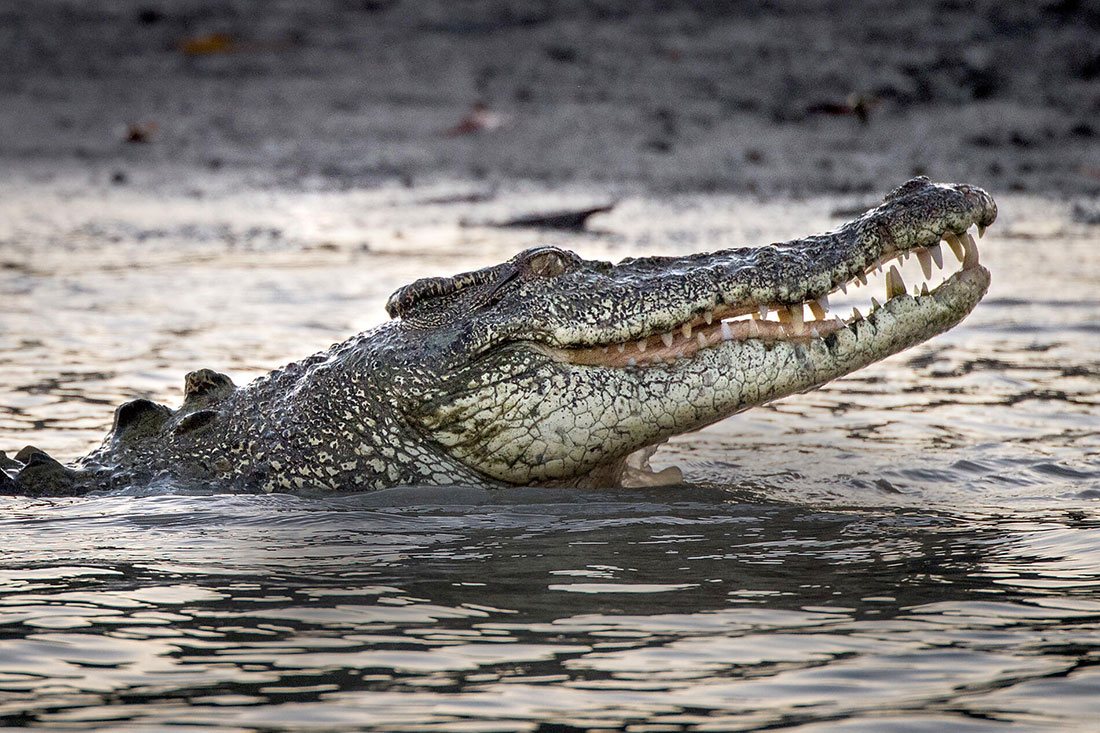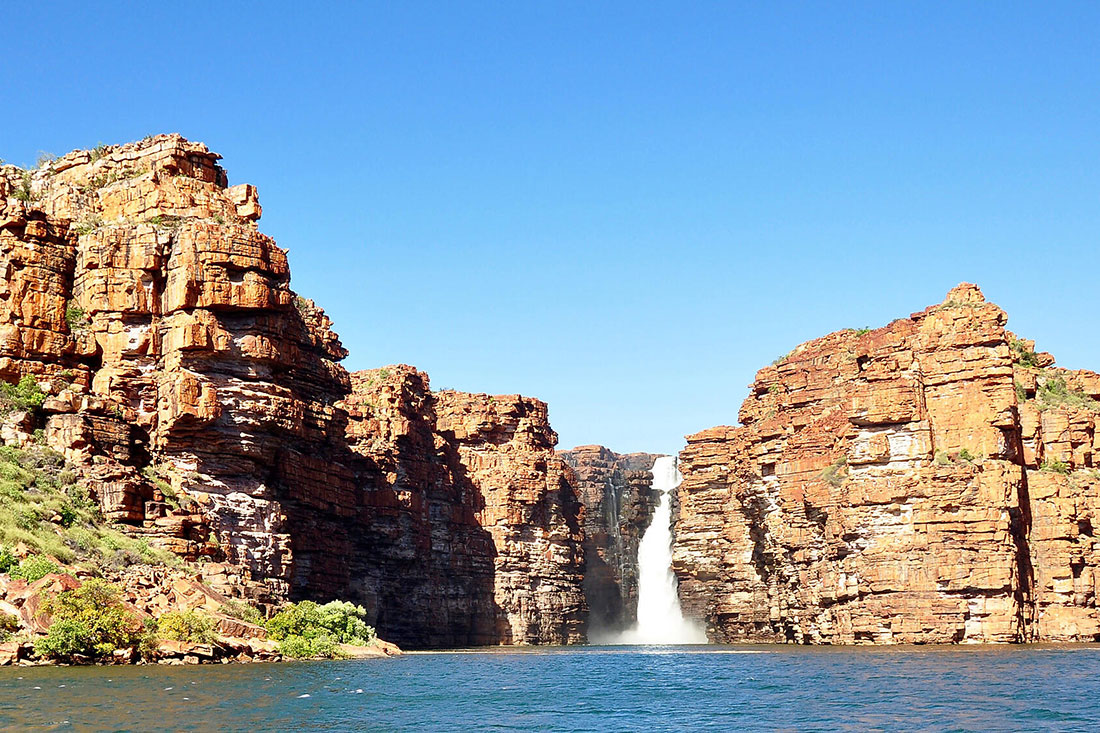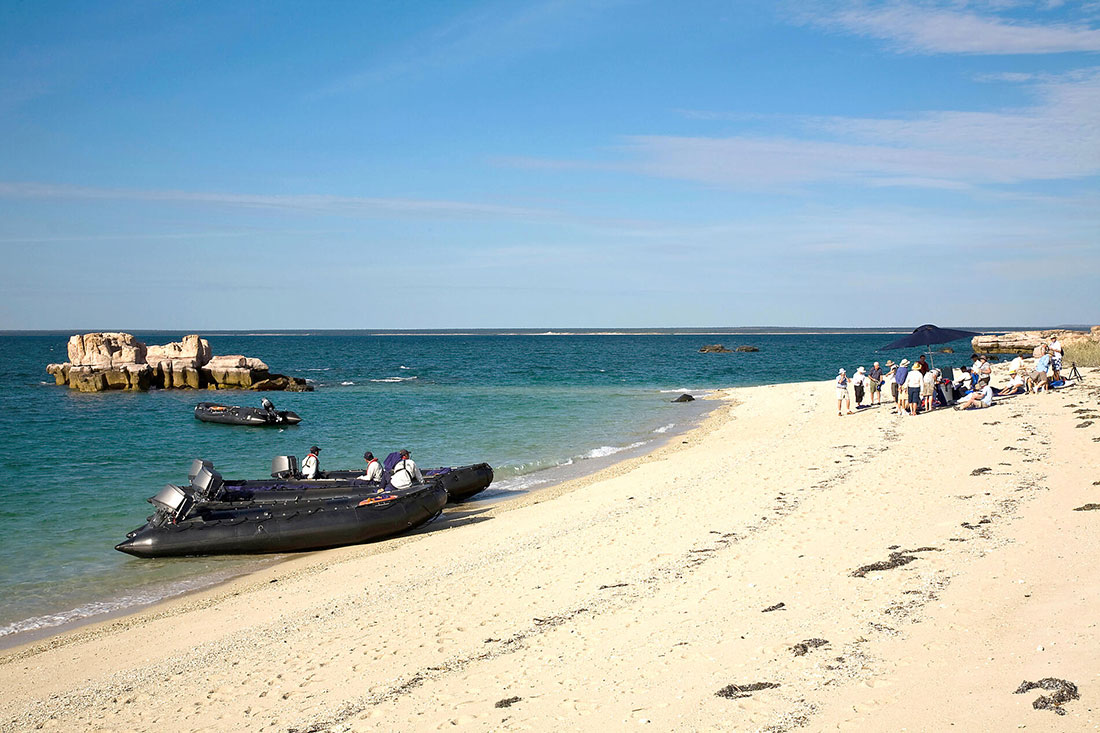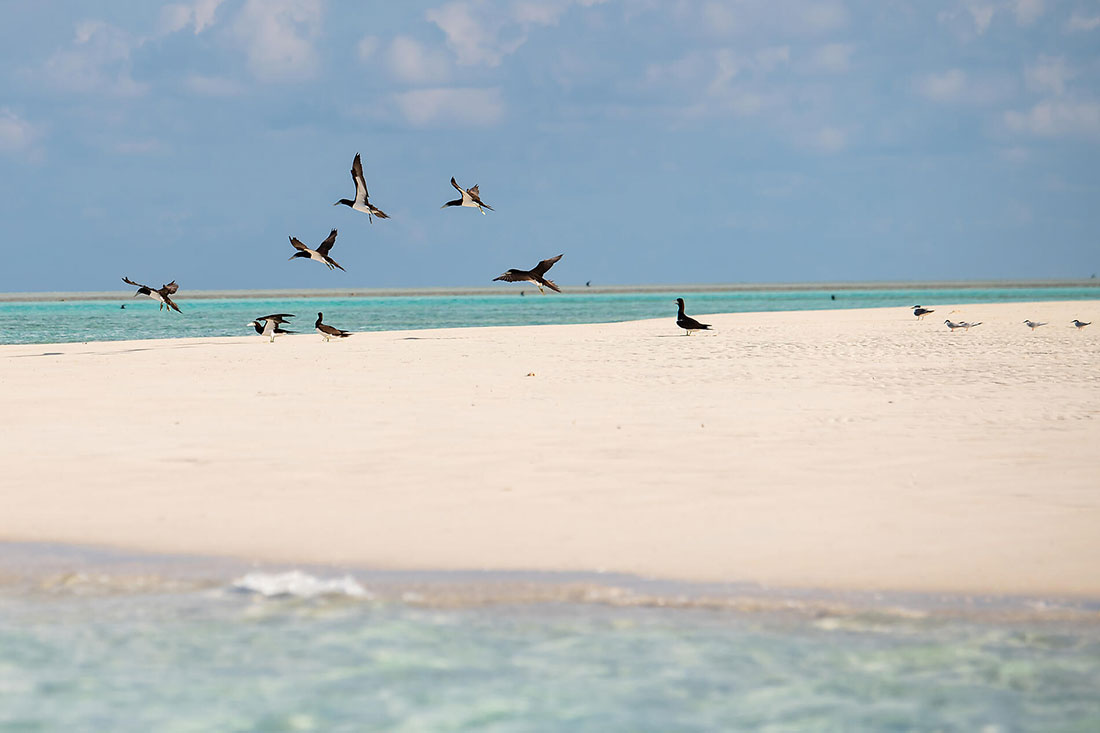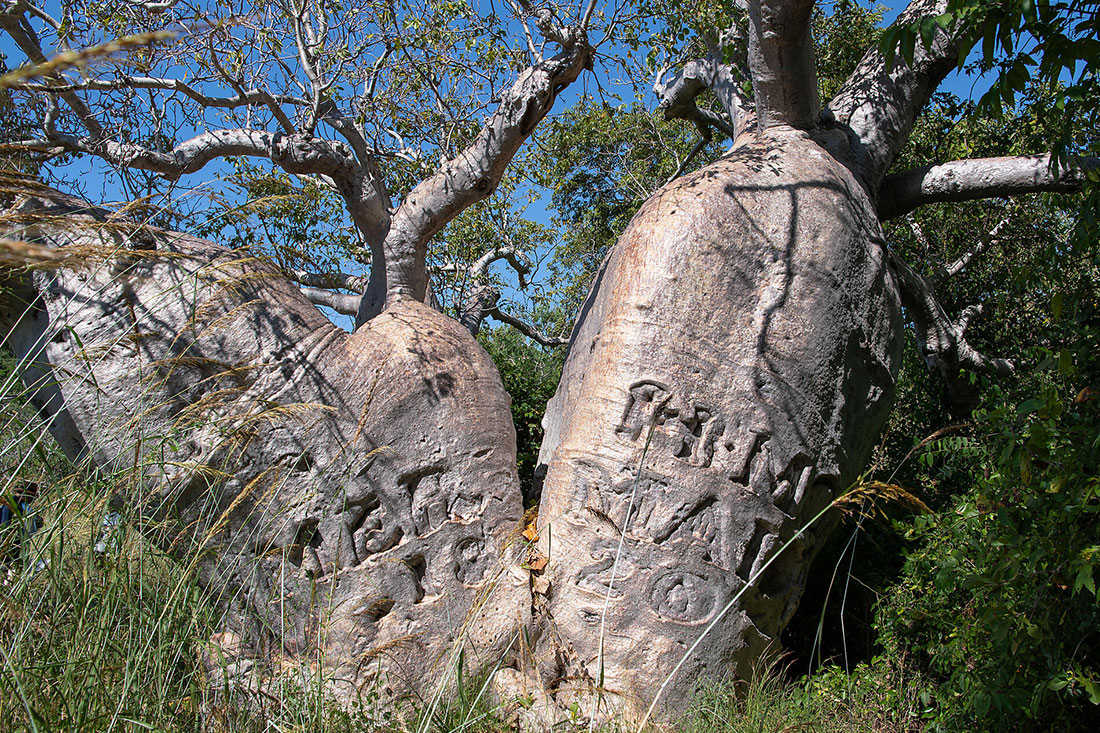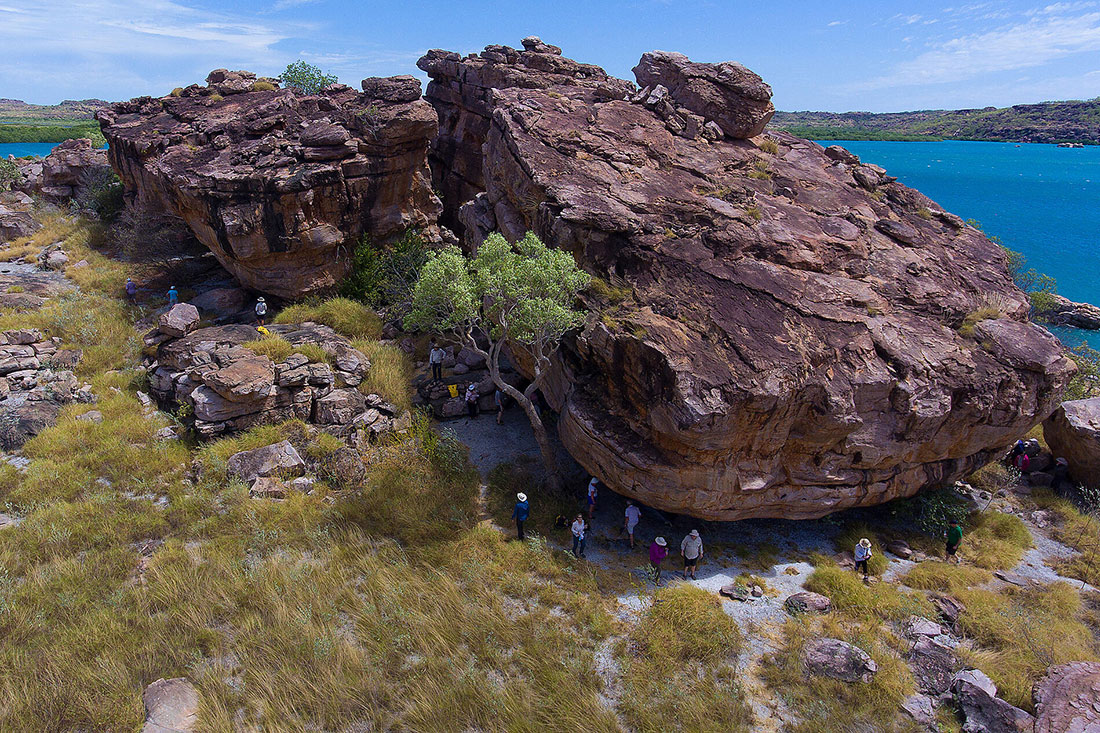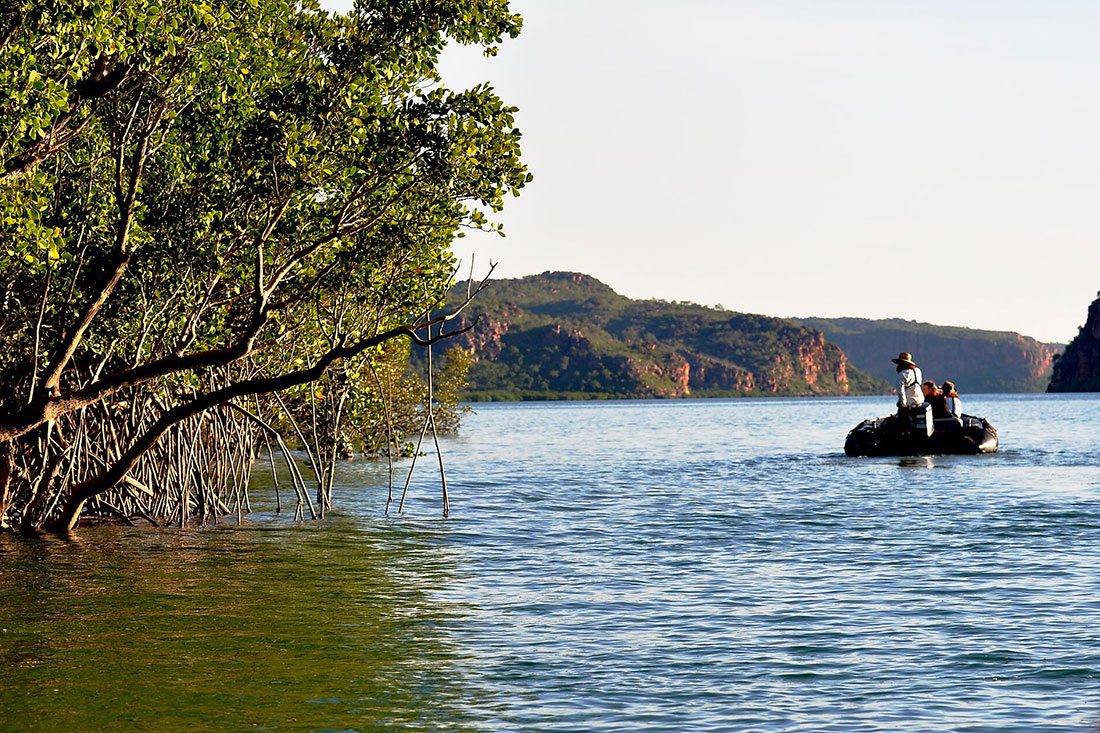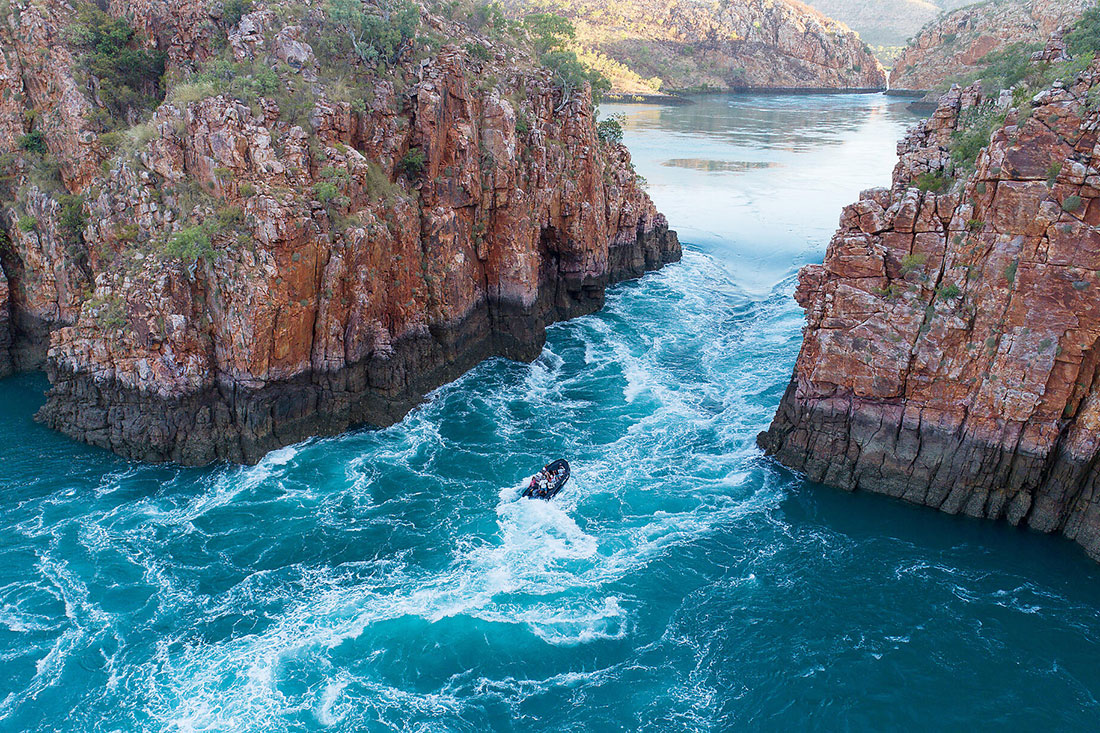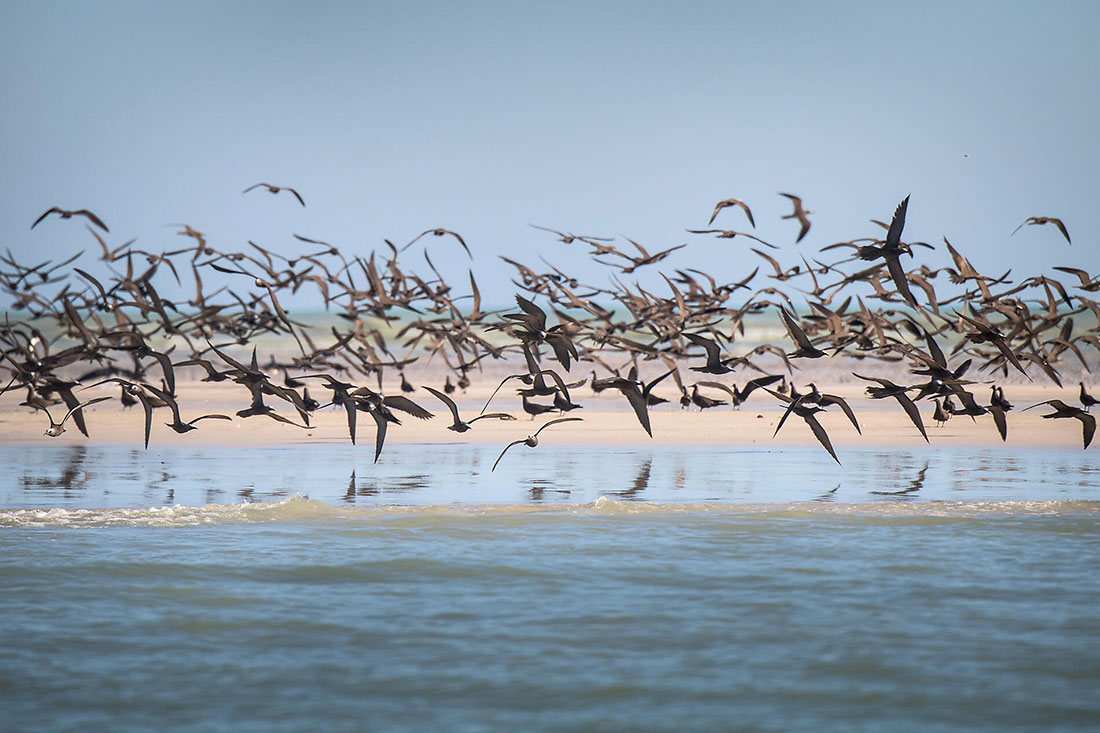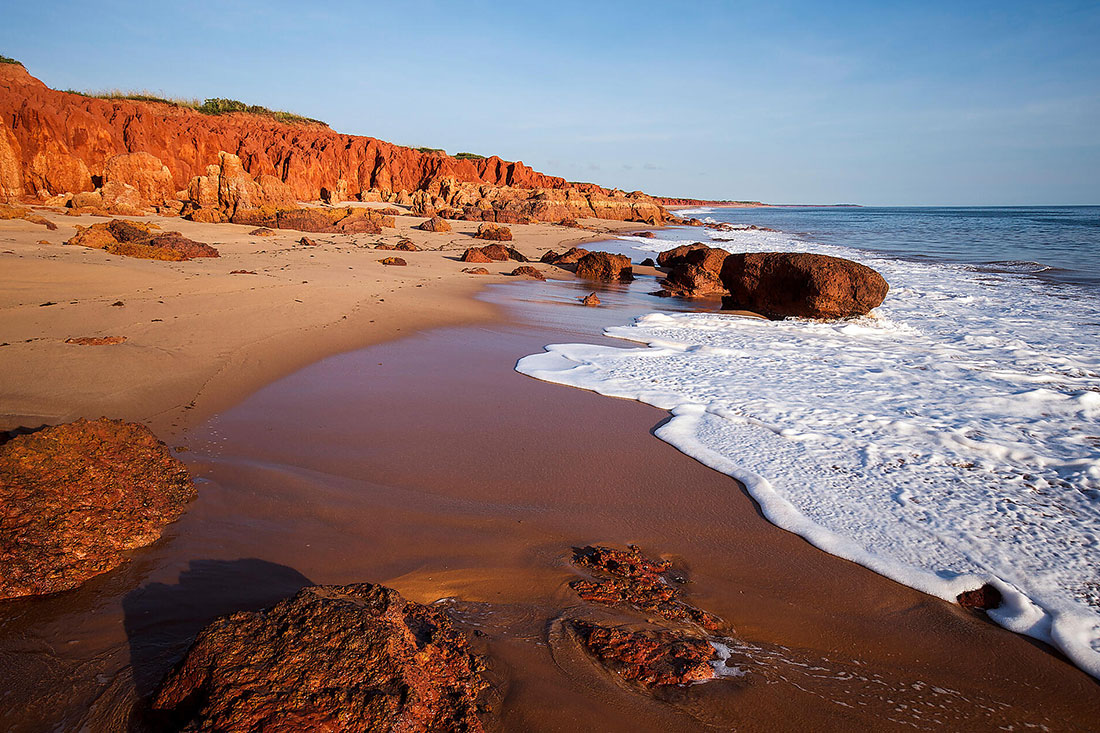CALL 1800 000 130
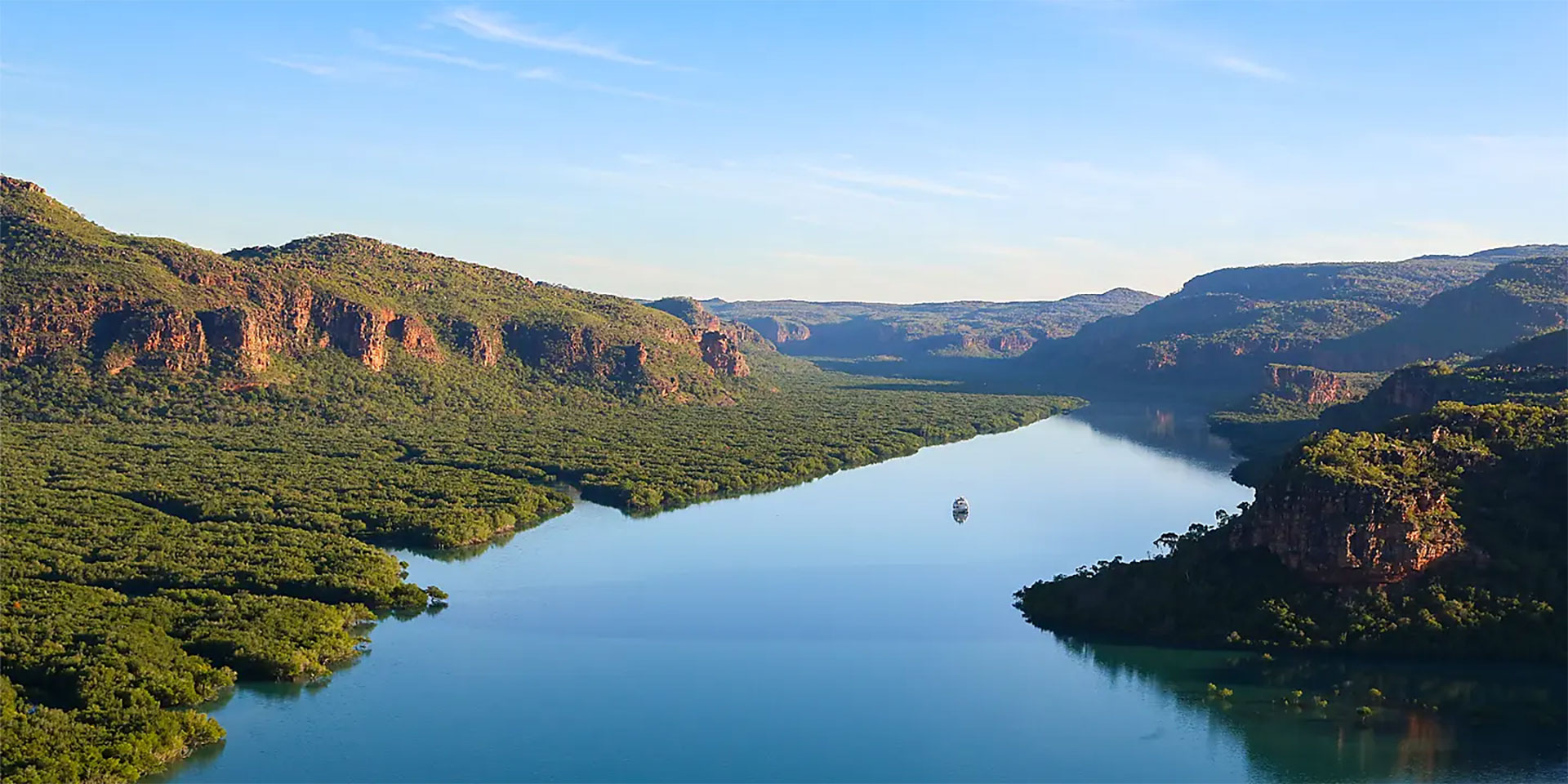
Ponant – The Iconic Kimberley Darwin to Broome
Darwin to BroomeAbout This Project
![]() Set sail for the wild and grandiose landscapes of Kimberley, following an exceptional PONANT itinerary.
Set sail for the wild and grandiose landscapes of Kimberley, following an exceptional PONANT itinerary.
From Darwin to Broome, embark for an 11-day expedition cruise to one of the last unspoiled regions on the planet.
The highpoint of this cruise will undoubtedly be the discovery of the King George River and the majestic Twin Falls, the highest falls in Western Australia.
During your cruise, the magnificent bays of Vansittart and Swift will offer you exceptional panoramas, between islands, secret inlets, caves and rocky overhangs.
In one of the most picturesque parts of the region, the Hunter River, you will see wild mangrove forests where saltwater crocodiles live along with many species of birds.
You will also visit Collier Bay, where you will be able to admire the Montgomery Reef, home to vast expanses of lagoons and immense coral reefs.
On the Lacepede Islands, take the time to admire the abundance of nesting birds as well as the large population of turtles residing in the lagoon.
Your ship will take you along the most spectacular coasts in the entire region.
With their falls, abrupt gorges, savannah, calm waters and desolate mountain chains, the wild lands of Kimberley are the promise of an exceptional adventure.
We are privileged guests in these extreme lands where we are at the mercy of weather and tide conditions. Landings on certain sites and the observation of certain wildlife cannot be guaranteed. They vary from day to day, making each PONANT cruise a unique experience. The Captain and the Expedition Leader will make every effort to ensure that your experience is as rich as possible, whilst complying with the necessary safety rules and precautions.
Highlights
- Join our highly qualified local expedition team
- Enjoy regular zodiac outings & shore visits to get close to Kimberley nature
- Discover billions of years-old landscapes & ancient rock art
- Listen to stories of the dreamtime from the oldest continuous culture on the planet
- Explore pristine mangrove environments, home to the world’s largest living reptile
- Possibility to reach the Mitchell Falls by helicopter, from Hunter River.
- Witness unique tidal phenomena such as the Horizontal Falls
Itinerary
 |
Day 1Darwin Darwin is located in Australia’s Northern Territory which is also known as the “Top End”. It is the capital city and the most populated town of the Northern Territory. Darwin is a beautiful tropical city, a melting pot of people and cultures, over 50 different cultures live and work side by side that prides itself in its unique and friendly laid-back lifestyle. Come discover the town’s still recent history through its emblematic buildings such as the new Parliamant House opened in 1994, a magnificent example of tropical architecture or Admiralty House declared heritage place, a tropical-style home elevated on stilts that has survived two cyclones and numerous air raids. |
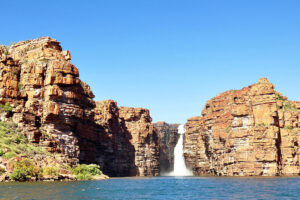 |
Day 2King George River The journey up the King George River is nothing short of breathtaking. The 80-metre-high sides of the gorge display varying degrees of weathering of the ancient Warton sandstone. The colours and textures of the gorge change with the light as you travel further up the river creating a continual changing scenery that is simply stunning. The journey culminates at the King George twin falls; the highest single-drop falls in the whole of the Kimberley (80 m or 260 ft). Fed by wet season run-off the level of water cascading over the falls varies from year to year. Your Expedition Team will escort you in either the zodiacs or ships tenders to the foot of the twin falls, and explain all about the stunning geological formations of the canyon. |
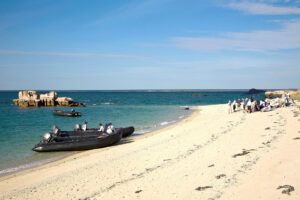 |
Day 3Vansittart Bay Jar Island contains ancient rock art galleries depicting the Gwion Gwion style unique to the Kimberley region. Mainly neglected by, or unknown to, the early European researchers of Aboriginal culture in the Kimberley in favour of the dominant and more dramatic Wandjina art, Gwion Gwion art has in recent years gained world prominence. It is generally thought that this art may extend back to over 30,000 years before our time and represents the first wave of seagoing colonisers of the Australian continent. As it is, these are the oldest detailed depiction of human figures in the world. Join your Expedition Team ashore for a short walk, past some fascinating rock formations, to the site of the Gwion Gwion art galleries. |
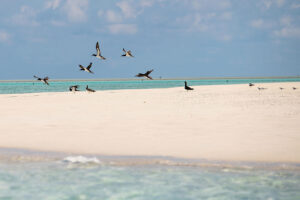 |
Day 4Ashmore Reef Located 600km North of Broome, on the edge of the continental shelf, Ashmore reef consists of 3 low-lying tropical islands surrounded by coral reef. The islands have a combined land area of approximately 54 hectares and are a designated important bird area (IBA). Visitation to Ashmore reef and Islands is strictly controlled and most of the reef is designated as a sanctuary zone where access is prohibited. Our visit to Ashmore reef is required to ensure we comply with Australian government regulations. Should weather, sea and tide conditions permit there may be an opportunity for guests to undertake a zodiac tour to the vicinity of West Island. |
 |
Day 5Careening Bay Careening Bay was named by Lieutenant Phillip Parker King after his ship, HMC Mermaid, was careened there during his third voyage of discovery in 1820. King surveyed the western coast to complete the map initiated by Flinders 20 years earlier. The Mermaid had been leaking badly and King needed to find a shallow sandy bay where he could careen his boat to undertake repairs. At a high tide, on a warm September afternoon, he ran the Mermaid onto the sands. For ten days the Mermaid crew worked hard before refloating the vessel. The ship’s carpenter carved the name of the vessel and the year into a conspicuous boab tree. The famous boab tree is now 3 metres wide and National Heritage listed. A reminder of a by gone era of exploration! |
 |
Day 6Swift Bay The Bonaparte Archipelago, is a stunningly rugged maze of islands stretching almost 150 km along Western Australia’s remote Kimberley coast. Its colour and scale conspire to take ones’ breath away. Its distant location has meant it has remained an unspoilt and remarkably pristine location to explore and experience. Phillip Parker King named “Swift’s bay” after Jonathon Swift (1667-1745) the author of Gulliver’s travels. The ‘T’ shaped bay is composed of heavily fractured sandstone providing an abundance of rock shelters. On the walls of these shelters are examples of both Wandjina and Gwion Gwion style rock art. Join your expedition team ashore for a guided walk to a number of rock art galleries depicting these unique rock art styles. |
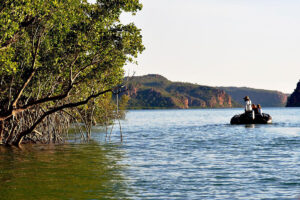 |
Day 7Hunter River Arguably one of the most scenic parts of the Kimberley coast, Prince Frederick Harbour and the Hunter River are lined with ancient rainforest pockets, pristine mangroves and mosaic sandstone cliffs. They are considered to be some of the most pristine mangrove forests in the world, containing up to 18 different species, supporting a rich and diverse fauna. The sandstone escarpment at the river mouth, known as “Kampamantiya” rises over 200 metres high before giving way to extensive mud banks and mangrove forests home to numerous bird species and the iconic saltwater crocodile. Our expert Expedition Team will share their knowledge with you as you explore this pristine mangrove environment by zodiac keeping a constant lookout for wildlife. You will also have the opportunity to reach the Mitchell Falls by helicopter from Naturalist Island beach. |
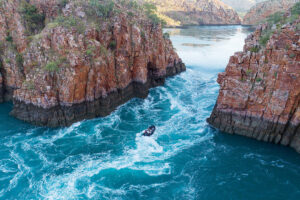 |
Day 8Collier Bay Lying to the east of the Buccaneer archipelago, the ancient landscapes of Collier Bay have been shaped by the massive tidal movements the region is renowned for, creating a photographer’s paradise. With a tidal range exceeding 14 metres, recorded near Yule entrance at the southern end of the bay, they are among the largest in the world. This massive daily movement of water creates unique phenomena that occur nowhere else in the world. Nestled in the centre of the Bay is Montgomery Reef, the world’s largest inshore reef system. As the tide falls a raging torrent of water cascades off the top of the reef, creating turbulent ‘rivers’ and mini waterfalls. At the Southern end of the Bay, Talbot Bay is home to the world’s only ’Horizontal Falls’ described by Sir David Attenborough as “One of the greatest wonders of the natural world.” Hidden in the many caves and grottos of this ancient landscape are a multitude of ancient Rock Art galleries. Here you can find spectacular examples of the Wandjina and Gwion Gwion styles. As we are at the mercy of weather and tide conditions in this region, the activities mentioned above are only possible experiences and can’t be guaranteed. |
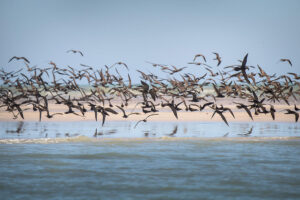 |
Day 9Lacepede Islands The Lacepede Islands are Western Australia’s most important breeding habitat for Green Turtles (Chelonia mydas), and have been named by BirdLife International as an Important Bird Area (IBA). The breeding colony of Brown Boobies is possibly the largest in the world. Up to 20,000 Roseate Terns have also been recorded here. Other birds breeding on the islands include Masked Boobies, Australian Pelicans, Lesser Frigatebirds, Eastern Reef Egrets, Silver Gulls, Crested, Bridled and Lesser Crested Terns, Common Noddies, Pied and Sooty Oystercatchers. Join your expedition team for a guided zodiac tour to view the prolific wildlife. Due to the sensitive nature of the environment, landings are prohibited on the Lacepede Islands. |
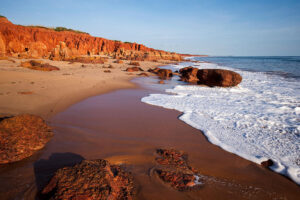 |
Day 10Broome Located in the northwest of the Kimberley region and in the far north of Western Australia, the town of Broome is reputed for its history and its glorious pearling era. The fascinating Chinatown district, which is the historic city centre, and the famous Japanese Cemetery, dates back to 1896, and has a past marked by the immigration of numerous Chinese and Japanese workers, attracted by the prosperous pearl industry at the end of the 19th century and at the beginning of the 20th century. Broome is also famous for the “Staircase to the Moon”, an optical illusion created by the Moon reflecting on the sand banks at low tide, like a staircase climbing up towards the sky, a unique spectacle provided by nature… |
Ponant Rates
| Ponant Rates 2025 (per person / twin share) | ||
|---|---|---|
| Le Jacques-Cartier | Sq Mtrs | Fares |
| Balcony – Deluxe Stateroom | 21 inc verandah | $12,520 |
| Balcony – Prestige Deck 4 | 21 inc verandah | $13,870 |
| Balcony – Prestige Deck 5 | 21 inc verandah | $14,540 |
| Balcony – Prestige Deck 6 | 21 inc verandah | $15,350 |
| Balcony – Deluxe Suite | 27 inc verandah | $19,940 |
| Balcony – Prestige Deck 5 | 32 inc verandah | $24,000 |
| Balcony – Privilege Suite 6 | 32 inc verandah | $24,000 |
| Balcony – Grand Deluxe Suite 5/6 | 45 inc verandah | $26,700 |
| Balcony – Owners Suite | 45 inc verandah | $38,920 |
| Ponant Rates 2026 (per person / twin share) | ||
|---|---|---|
| Le Jacques-Cartier | Sq Mtrs | Fares |
| Balcony – Deluxe Stateroom | 21 inc verandah | $12,630 |
| Balcony – Prestige Deck 4 | 21 inc verandah | $14,010 |
| Balcony – Prestige Deck 5 | 21 inc verandah | $14,360 |
| Balcony – Prestige Deck 6 | 21 inc verandah | $15,500 |
| Balcony – Deluxe Suite | 27 inc verandah | $20,030 |
| Balcony – Prestige Deck 5 | 38 inc verandah | $24,200 |
| Balcony – Privilege Suite 6 | 38 inc verandah | $25,310 |
| Balcony – Grand Deluxe Suite 5/6 | 45 inc verandah | $26,150 |
| Balcony – Owners Suite | 45 inc verandah | $39,070 |
| Le Soleal | Sq Mtrs | Fares |
| Window – Superior | 21 interior | $11,710 |
| Balcony – Deluxe Stateroom | 21 inc verandah | $12,680 |
| Balcony – Prestige Deck 4 | 21 inc verandah | $14,010 |
| Balcony – Prestige Deck 5 | 21 inc verandah | $14,710 |
| Balcony – Prestige Deck 6 | 21 inc verandah | $15,550 |
| Balcony – Deluxe Suite | 27 inc verandah | $20,030 |
| Balcony – Prestige Suite from | 37 inc verandah | $24,200 |
| Balcony – Owners Suite | 45 inc verandah | $39,070 |
*Fares listed are based on Ponant’s best promotional fares 30% savings though savings are capacity controlled and will vary between 30-5% date by date.
Category
PonantWe’ll help you plan the perfect Kimberley cruise at the best price guaranteed Help Me Find My Cruise

